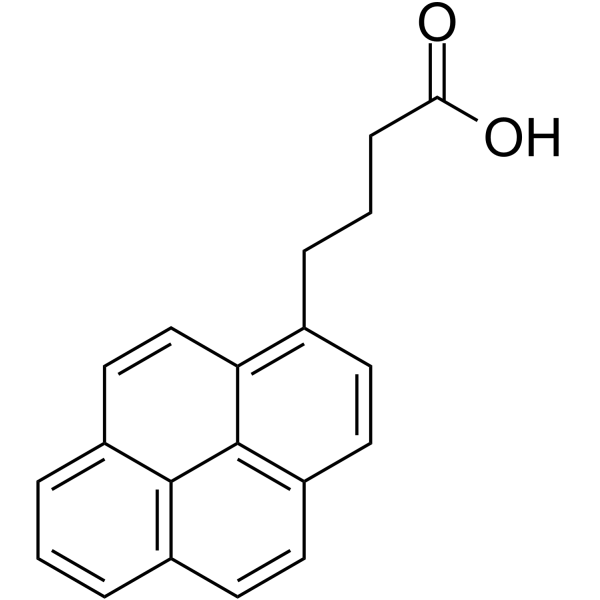1-Pyrenebutyric Acid

1-Pyrenebutyric Acid structure
|
Common Name | 1-Pyrenebutyric Acid | ||
|---|---|---|---|---|
| CAS Number | 3443-45-6 | Molecular Weight | 288.340 | |
| Density | 1.3±0.1 g/cm3 | Boiling Point | 515.9±19.0 °C at 760 mmHg | |
| Molecular Formula | C20H16O2 | Melting Point | 184-186 °C(lit.) | |
| MSDS | Chinese USA | Flash Point | 412.3±16.6 °C | |
| Symbol |

GHS07 |
Signal Word | Warning | |
|
Investigations by Protein Film Electrochemistry of Alternative Reactions of Nickel-Containing Carbon Monoxide Dehydrogenase.
J. Phys. Chem. B 119 , 13690-7, (2015) Protein film electrochemistry has been used to investigate reactions of highly active nickel-containing carbon monoxide dehydrogenases (CODHs). When attached to a pyrolytic graphite electrode, these enzymes behave as reversible electrocatalysts, displaying CO... |
|
|
Surface modifications for enhanced enzyme immobilization and improved electron transfer of PQQ-dependent glucose dehydrogenase anodes.
Bioelectrochemistry 105 , 78-87, (2015) Pyrroloquinoline quinone dependent soluble glucose dehydrogenase (PQQ-sGDH) enzymatic MWCNT electrodes were p roduced using 1-pyrenecarboxylic acid (PCA) activated through carbodiimide functionalization and 1-Pyrenebutyric acid N-hydroxysuccinimide ester (PBS... |
|
|
Application of graphene-pyrenebutyric acid nanocomposite as probe oligonucleotide immobilization platform in a DNA biosensor.
Mater. Sci. Eng. C. Mater. Biol. Appl. 33(7) , 3851-7, (2013) A stable and uniform organic-inorganic nanocomposite that consists of graphene (GR) and pyrenebutyric acid (PBA) was obtained by ultrasonication, which was characterized by scanning electron microscopy (SEM) and UV-vis absorption spectra. The dispersion was d... |
|
|
Fabrication of Ultrasensitive Field-Effect Transistor DNA Biosensors by a Directional Transfer Technique Based on CVD-Grown Graphene.
ACS Appl. Mater. Interfaces 7 , 16953-9, (2015) Most graphene field-effect transistor (G-FET) biosensors are fabricated through a routine process, in which graphene is transferred onto a Si/SiO2 substrate and then devices are subsequently produced by micromanufacture processes. However, such a fabrication ... |
|
|
Osteological, biomolecular and geochemical examination of an early anglo-saxon case of lepromatous leprosy.
PLoS ONE 10 , e0124282, (2015) We have examined a 5th to 6th century inhumation from Great Chesterford, Essex, UK. The incomplete remains are those of a young male, aged around 21-35 years at death. The remains show osteological evidence of lepromatous leprosy (LL) and this was confirmed b... |
|
|
Human tuberculosis predates domestication in ancient Syria.
Tuberculosis (Edinb.) 95 Suppl 1 , S4-S12, (2015) The question of pre-neolithic tuberculosis is still open in paleopathological perspective. One of the major interests is to explore what type of infection could have existed around the early stage of animal domestication. Paleopathological lesions evoking ske... |
|
|
On-chip graphene oxide aptasensor for multiple protein detection.
Anal. Chim. Acta 866 , 1-9, (2015) The versatility of an on-chip graphene oxide (GO) aptasensor was successfully confirmed by the detection of three different proteins, namely, thrombin (TB), prostate specific antigen (PSA), and hemagglutinin (HA), simply by changing the aptamers but with the ... |
|
|
Role of Quinones in Electron Transfer of PQQ-Glucose Dehydrogenase Anodes—Mediation or Orientation Effect.
J. Am. Chem. Soc. 137 , 7754-62, (2015) In this study, the influence of two quinones (1,2- and 1,4-benzoquinone) on the operation and mechanism of electron transfer in PQQ-dependent glucose dehydrogenase (PQQ-sGDH) anodes has been determined. Benzoquinones were experimentally explored as mediators ... |
|
|
Label-Free Electrical Immunosensor for Highly Sensitive and Specific Detection of Microcystin-LR in Water Samples.
Environ. Sci. Technol. 49 , 9256-63, (2015) Microcystin-LR (MCLR) is one of the most commonly detected and toxic cyclic heptapeptide cyanotoxins released by cyanobacterial blooms in surface waters, for which sensitive and specific detection methods are necessary to carry out its recognition and quantif... |
|
|
Preparation of pyrenebutyric acid bonded silica stationary phases for the application to the separation of fullerenes.
J. Chromatogr. A. 1083(1-2) , 23-31, (2005) A novel immobilization method was proposed for the preparation of pyrenebutyric acid-bonded silica (PYB-silica) stationary phases. The pyrene moiety was grafted to silica gel through spacers of aminoalkyl silanes. The HPLC separation of C60, C70 and higher fu... |